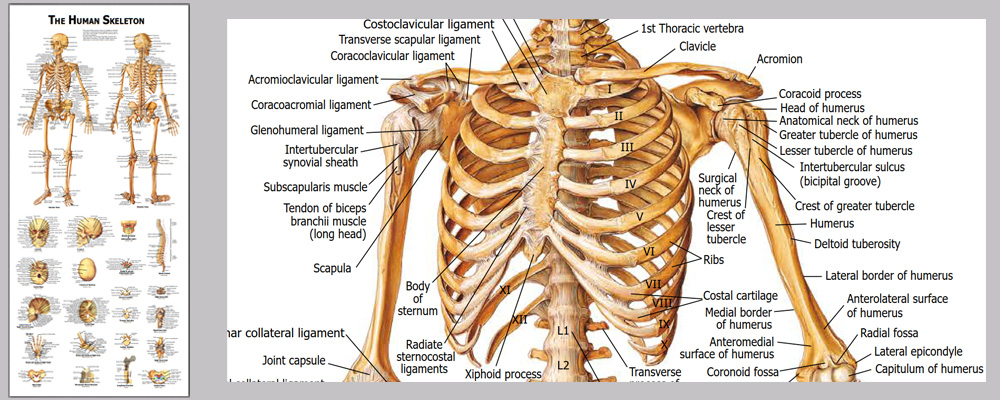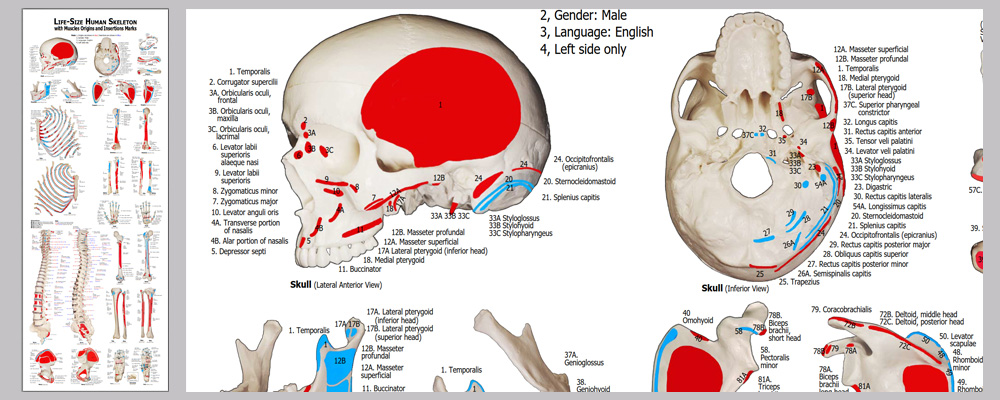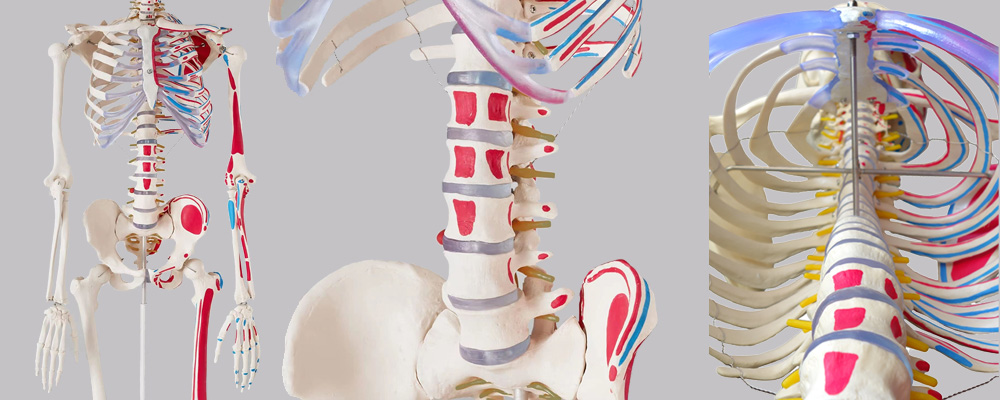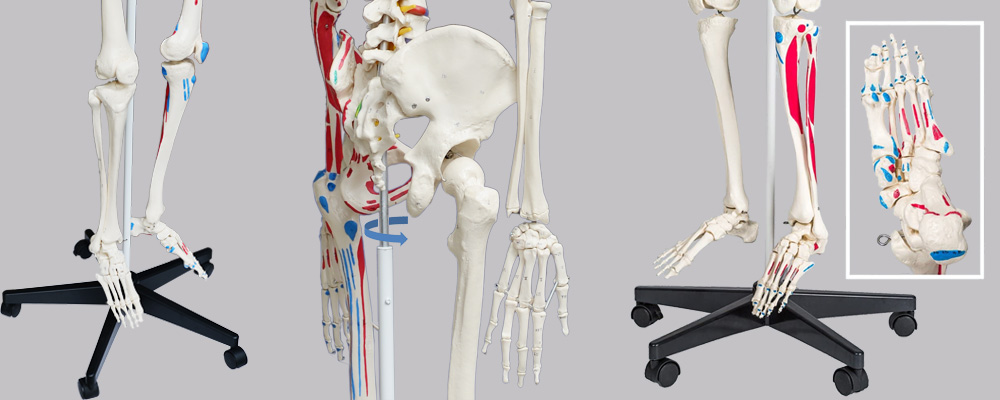interactive human skeleton model
This life size articulated adult human skeleton model is 180cm tall & ideal for teaching / learning the basics of human anatomy. Includes a colorful Human Skeleton chart to show all the detailed structures for reference.Detailed colorful chart with over 630 accurate definitions. Durable and no reflection with matte film covered, 36 * 78cm

Detailed muscles origins and insertions with codes. Durable and no reflection with matte film covered, 100cm * 38cm

Stainless steel wires keep the ribs gaps stable.

2 of 5 casters are lockable.

An overview of JC anatomy advantages: • Hand-painted muscle origins and insertions • Flexible spine and ligaments • Slipped disc between the 3rd and 4th lumbar vertebrae • Protruding spinal nerves and vertebral arteries • 3-part assembled skull with individually inserted teeth • Made from a durable, unbreakable synthetic material • Top quality, life size natural casting • lMultiple Applications -photography,photography,photography, etc. • lChart - Detailed colorful chart with about 726 accurate definitions. Durable and no reflection with matte film covered, 36 * 78cm • On a stable metal stand with 5 casters (painted white) • Full size dust cover keeps model clean while in storage • Exceptional value for money with a 3 year guarantee • interactive human skeleton model Easy to use - Main joints are movable. Skull, skullcap arms, legs, crus, feet are removable.
| Product name | interactive human skeleton model |
| Place of Origin | Shenzhen China |
| Product Material | PVC, ABS, SST |
| Rib cage | A 5mm dia |
| Human skeleton model life | 15years |
| Surface treatment | Polish. Etched. Texture |
| SUPPORT 24/7 | Contact us 24 hours a day, 7 days a week |
| Size | 67 * 32 * 123 |
| Port | Shenzhen |
| PAYMENT & ORDERING | PayPal account or pay by credit card |
interactive human skeleton model FAQs Guide Are you looking for a quick review guide about interactive human skeleton model? An ultimate FAQs buying guide is available to help you.This guide contains all the information about all the important facts, figures, and various processes regarding interactive human skeleton model. Let’s continue!
2.Can this interactive human skeleton model be used as an aid to human learning?
3.What are the different types of interactive human skeleton model available?
4.Does the manufacturer of this interactive human skeleton model provide relevant anatomy teaching materials?
5.How to correctly assemble and utilize a interactive human skeleton model?
6.Is this interactive human skeleton model suitable for anatomy learning?
7.About interactive human skeleton model raw materials
8.About the scale of interactive human skeleton model factory
9.Why is a interactive human skeleton model important in medical education?
10.About interactive human skeleton model production equipment
11.What kind of material is used to make the interactive human skeleton model?
12.Can the interactive human skeleton model display many different body poses?
13.Can this interactive human skeleton model be used as a simulation tool for sports training?
1.Can bone diseases such as osteoporosis be displayed on the interactive human skeleton model?
Yes, bone diseases like osteoporosis can be displayed on a human skeleton model. A human skeleton model is a representation of the bones and joints of the human body and can be used to educate and train students and medical professionals. Osteoporosis is a bone disease that results in weakened and porous bones, increasing the risk of fractures. As a result, there are certain features and changes in the bone structure that can be seen on a human skeleton model.
2.Can this interactive human skeleton model be used as an aid to human learning?
Yes, this Human skeleton model can be used as an aid to human learning in various ways. It is a representation of the human skeleton, which is the framework of bones that supports the body and protects internal organs. This model can be used as a hands-on learning tool in classrooms, medical schools, and other educational settings. Firstly, it can be used to help students understand the structure and functions of the human skeleton. By examining the bones and their placement, students can learn about the different types of bones, such as long bones, flat bones, and irregular bones, and how they work together to facilitate movement and support the body. This model also allows students to visualize the various joints, their types and movements, and how they are connected to each other. Overall, this Human skeleton model can be a valuable tool in human learning as it provides a tangible and visual representation of the skeletal system. It allows for interactive and hands-on learning, making it easier for students to grasp complex concepts. With its versatility and usefulness in different disciplines, it can serve as an effective aid in enhancing human learning.
3.What are the different types of interactive human skeleton model available?
1. Anatomical Skeleton Models: These models are exact replicas of the human skeletal system and are used for educational and medical purposes. They are typically made of high-quality materials such as plastic or resin and come with detailed labels for each bone, making it easy to identify and study different structures. 2. Disarticulated Skeleton Models: These models consist of individual bones that can be separated from each other. They are often used in classrooms for teaching purposes as they allow students to handle and study each bone individually, facilitating a more hands-on learning experience. 3. Flexible Skeleton Models: These models are made from a flexible material such as rubber or PVC and are designed to mimic the movements of the human body. They are often used in medical training and rehabilitation settings to demonstrate muscle and joint movements. 4. Life-size Skeleton Models: As the name suggests, these models are the same size as an actual human skeleton. They are most commonly used in medical schools and hospitals for teaching and training purposes.
4.Does the manufacturer of this interactive human skeleton model provide relevant anatomy teaching materials?
Yes, we provide a series charts to support teaching and learning
5.How to correctly assemble and utilize a interactive human skeleton model?
When assembling and utilizing a human skeleton model, there are several steps to follow to ensure correct positioning and accurate representation of the skeletal system. Below is a step-by-step guide to properly assemble and utilize a human skeleton model: 1. Gather all the necessary components: The first step is to gather all the pieces of the human skeleton model, which typically includes a skull, rib cage, spinal column, arms, and legs. Make sure that all the pieces are present and in good condition. 2. Identify the bones: Before assembling the skeleton, it’s important to familiarize yourself with the different bones and their names. The skull, for example, has different parts such as the cranium, mandible, and maxilla, while the spinal column consists of the cervical, thoracic, lumbar, sacrum, and coccyx vertebrae. 3. Attach the arms and legs: Next, attach the arms and legs to the skeleton. Start by connecting the arms to the shoulder sockets and then attach the hand bones to the arms using the elbow and wrist joints. For the legs, connect the femur (thigh bone) to the hip socket, followed by the tibia and fibula (lower leg bones), and finally the foot bones.
6.Is this interactive human skeleton model suitable for anatomy learning?
Yes, this human skeleton model is suitable for anatomy learning for several reasons. 1. Lifelike appearance: The model closely resembles the human skeleton in terms of size, shape, and detail. This makes it easier for students to visualize and understand the placement and functioning of bones in the human body. 2. Detailed labeling: The model comes with detailed labeling of all the bones and structures, helping students to learn the correct terminology and understand the location and function of each bone. 3. Removable parts: The model has removable limbs, joints, and other parts, allowing students to explore and study the underlying supportive, connective, and reproductive structures, such as ligaments, tendons, and cartilage. 4. Durable materials: The model is made of high-quality, durable materials that can withstand regular handling, making it suitable for use in classrooms, laboratories, and homes. 5. Realistic movement: The model's limbs can be moved in a way similar to human movement, making it an effective tool for demonstrating physiological processes and the range of motion of different joints. 6. Interactive learning: This model can be used in interactive learning sessions, such as small group discussions and hands-on activities, to foster a deeper understanding of the human skeleton and its functioning.
7.About interactive human skeleton model raw materials
PVC, ABS, SST
8.About the scale of interactive human skeleton model factory
Covering an area of about 2000 m². This would include manufacturing space for assembly, molding, and finishing processes, as well as storage space for raw materials and finished products.
9.Why is a interactive human skeleton model important in medical education?
Better understanding of the structure, function, and pathological changes of the skeletal system. Deeper understanding of the pathogenesis of skeletal diseases. To demonstrate and explain treatment methods for skeletal diseases
10.About interactive human skeleton model production equipment
The production of a human skeleton model requires a variety of specialized equipment to ensure accuracy, durability, and detail in the final product. we around 50 sets dedicated equipment
11.What kind of material is used to make the interactive human skeleton model?
The human skeleton model is typically made out of a combination of materials, depending on the specific model and its intended use. Generally, the main materials used are plastic, metal, and sometimes, natural materials such as wood. Plastic: The majority of the skeleton model is made from a high-quality, durable plastic such as polyvinyl chloride (PVC) or polyethylene. These materials are lightweight and easy to mold into the intricate and specific shapes required for each bone in the skeleton. They are also easy to paint and can be colored to resemble real bones.
12.Can the interactive human skeleton model display many different body poses?
The Human skeleton model can display many different body poses in order to show the movement and positioning of bones and muscles. The model can be manipulated into a range of poses such as the classical anatomical position, where the arms are down by the sides, palms facing forward, and feet shoulder-width apart. It can also be posed to demonstrate actions such as walking, running, jumping, and sitting. The flexibility of the model allows for a wide range of movements to be shown, from simple movements of individual joints to complex combinations of actions involving multiple joints. Additionally, the model can display different body poses by adjusting the positions of individual bones and joints. For example, the arms can be raised or lowered, the elbows bent or straightened, and the fingers spread or closed. The legs can be straightened or bent at the knee, and the ankles can be rotated to show different directions of movement. These adjustments allow for a variety of poses to be demonstrated, from relaxed positions to more dynamic and active positions. In summary, the Human skeleton model can display a wide variety of body poses and movements, ranging from simple to complex, to showcase the functions and interactions of the bones and muscles in the human body.
13.Can this interactive human skeleton model be used as a simulation tool for sports training?
The Human skeleton model can definitely be used as a simulation tool for sports training. This model can be used in various ways to simulate different scenarios and movements that are specific to different sports. In conclusion, the Human skeleton model is a versatile tool that can be used to enhance sports training in various ways. It can help athletes and coaches understand and improve technique, prevent injuries, analyze and correct movement patterns, and simulate specific sports movements and scenarios. Thus, it can be a valuable resource for individuals looking to train and improve their performance in sports.




